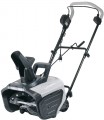Working width
The width of the strip of snow that the snow blower can clear in one pass. The larger the capture width, the fewer passes will be required to process the site, which is especially important on large areas. On the other hand, for processing small spaces, clearing individual paths, etc. significant width is not required (moreover, a “narrow” snow blower will pass more easily in a hard-to-reach place). The larger the capture width, the more powerful the engine, usually, ceteris paribus.
The most compact modern snow blowers have a working width of
less than 50 cm, these are mainly electric models of low power, although gasoline units are also found. A width of
50 – 60 cm can be called relatively small,
60 – 70 cm — medium, and in the largest models this figure
exceeds 70 cm.
Snow height
The maximum thickness of the snow layer that the snow blower removes in one pass. If you plan to regularly remove snow as it falls in a small area (for example, in the courtyard of your own private house), a grip height of up to 20 cm will be enough. If the opportunity to remove snow is rare (for example, in a country house where you visit only on weekends), you should pay attention to more powerful models with a height of about 50 cm.
Design
—
Self-propelled design. In self-propelled snow blowers, the built-in motor drives not only the auger, but also the wheels / tracks, ensuring the movement of the device. In this way, you do not have to push the snow blower by hand, which makes work much easier — especially with heavy, powerful models. Most self-propelled models have a transmission that allows you to adjust the speed of movement, as well as the ability to move backward (see "Number of gears").
—
Overload protection. A safety system that protects the unit from breakdowns in the event of critical loads. The main reason for the occurrence of such loads is the jamming of the screw — for example, due to the ingress of a foreign object. Therefore, most often, special bolts are used for protection, connecting the auger to the motor gearbox: with a sharp increase in load, the bolts are cut off and the auger is disconnected from the gearbox. Another option is overheating protection that reacts to engine temperature; it is found predominantly in electrical assemblies and can be used alone or in combination with shear bolts.
—
Headlights. The presence of a headlight (headlights) in the design of the snow blower allows you to use it for work at night, when there are no other light sources or they are not enough. In addition, in some models, the headlights turn on automatically every time the engine is starte
...d — they play the role of a warning signal that the unit is running.
— Heated handles. Heating system for handles, which the operator holds during work. This feature is especially useful as snow blowers are used in cold weather, and hands can get cold during prolonged use. On the other hand, with small volumes of cleaning, you can completely do with gloves, so heated handles are found mainly in powerful models with internal combustion engines, designed for large volumes of work.
